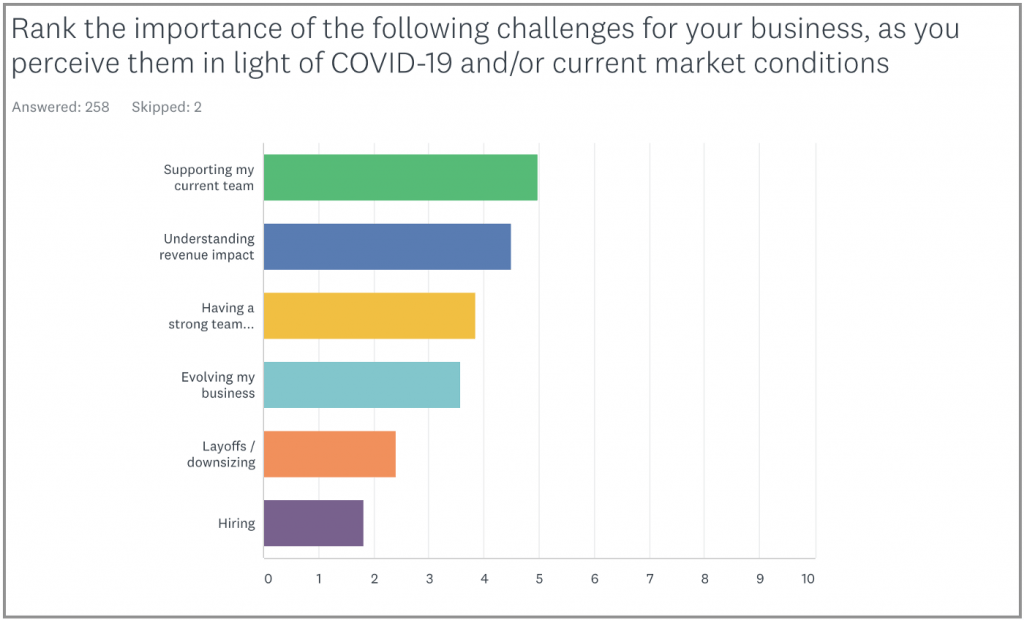
Descending the steps of a monastery, a young monk in training quizzes his master: “What are the differences between Heaven and Hell?”
“There are no material differences,” replies the old monk.
“None at all?” probes the trainee.
“Yes. Both Heaven and Hell look the same. However, each diner must use a pair of meter-long chopsticks to eat. In the case of Hell, people are always starved because no matter how hard they try, they fail to get food into their own mouths. In heaven, however, everyone is satiated because they feed the person sitting opposite them at the table. That’s the difference.”
So how is this parable relevant to lead generation and surviving a crisis?
For a lot of B2B companies, revenue is plunging right now.
Small businesses are either struggling financially or preserving cash until the crisis is over. This means fewer leads are coming through the door. Of the leads that are acquired, many of them have less budget to spend.
The result is a new sales landscape that is objectively more difficult than before.
In order for B2B companies to adapt, survive, and succeed in it, marketing and sales teams must take a page out of the zen playbook: To support themselves, they should first strengthen the team seated across them at the table.
Ahead, I’ll break down how marketing and sales teams can align unique insights, skills, and resources to generate leads and survive a crisis.
“Show empathy.”
The well-intended advice is becoming an ethereal platitude in modern business, parroted by marketing and sales teams everywhere.
Unfortunately, it’s also damaging the reputation of brands that broadcast “fake empathy.”
The viral video “Every Covid-19 Commercial is Exactly the Same” is a montage of big brands whose “empathy marketing” has backfired.
(They’ve even used the same somber background music!)
Instead of resonating with customers, aloof, artificial-looking empathy has triggered an uproar of comical aversion.

To avoid fake empathy and actually connect with leads, here are some practical ways for sales and marketing teams to help each other step into a buyer’s shoes:
Empathy isn’t acknowledging that “times are hard.”
Empathy isn’t trumpeting your corporate story and tying it to the fact that “we’re all in this together.”
Empathy is about answering the all-important question: “What are my prospect’s biggest priorities and problems right now, and how does my product/service help them?”
For more on the subject, read “Empathy is a superpower in marketing and sales”: A Q&A with Brian Carroll of Markempa
Buyers are not in a buying mood right now. Up to 40% of them are even saying no to booking sales meetings due to COVID-19.

For sales and marketing teams—whose dynamic roles are demanding under normal circumstances—COVID-19 renders the old ways of lead generation ineffective at best.
The first step for marketing, sales, and C-suite teams is to clear the fog of uncertainty by grasping the “new normal” and how they’ll adapt. This means coming together to:
When pitched the idea of the PlayStation by a then-junior employee, Ken Kutaragi, Sony bosses were not impressed. Their reaction was:
“What is this guy talking about?”
However, senior executives eventually came around. And today, the PlayStation is the best-selling console of all time.
A breakthrough insight that’s obvious to some may seem obscure and far-fetched to others. So invite observations and ideas from all departments, not just sales and marketing. Gather your team, survey your surroundings, and plan how sales and marketing will help each other over potential hurdles on the horizon.
Once there’s a substantial list of observations, marketing and sales can discuss solutions and prioritize the ones that are most likely to bear fruit.
With the expected challenges and changes listed out for both teams, necessary adaptations start to reveal themselves…
If reps aren’t trained on inside or digital sales, it’s time for them to learn. If the marketing team is yet to host webinars and remote events, now’s the time to start.
But those are obvious and reactive changes that each team instinctively knows are necessary, right?
In order for marketing and sales to actually support each other, they can’t just acknowledge looming challenges. They need to agree on how they’ll sharpen each other’s saws in order to overcome those challenges.
For example, with fewer events and in-person meetups, marketing might predict a spike in digital advertising costs and competition. To continue reaching leads, they can ask sales to find out how customers are struggling.
Based on the data gathered by reps, marketing can potentially answer real-time problems that customers face with relevant content that attracts leads into the funnel.
Sales, on the other hand, might foresee defensive, risk-averse buyers with stronger objections to the sale due to shrinking budgets.
To defuse doubts and lighten the fears that might be weighing on a prospect’s shoulders, they can ask marketing to supply reports, case studies, and social proof that prove ROI.
In a recent survey, less than 30% of business leaders reported growth as a priority during COVID-19.

Adapting to a new normal means updating baseline metrics and KPIs. This can be a bitter, but necessary pill to swallow for some.
Important tip: Data doesn’t always alert you to brewing changes immediately. To stay abreast of the shifting sales landscape, regularly review front-facing metrics such as:
Related: How to set smarter sales goals (and actually achieve them) in 4 easy steps
Your crisis-countering plan might not be a silver bullet that solves your revenue problems right away. But, having an aligned action plan will give your sales and marketing teams a single playbook to work from, which provides focus and boosts morale.
Remember, action always beats analysis.
Get your plan in writing, then encourage your team to adjust and update it with fresh data and observations as the sales landscape develops.
According to Neil Patel, data shows a COVID-19 related decline in conversions for industries across the board.

Apart from a few outlying verticals like food, medicine, and remote tech, most industries have taken a hit.
With the global switch to digital channels, content marketing will remain critical for inbound lead generation. But please, don’t publish content for the sake of publishing it.
Instead, use real-time sales and marketing data to create relevant content that’s useful to buyers. For example, Leadfeeder has been producing webinars that help viewers improve their outbound sales during COVID-19, while DataBox is using its resources to publish trending research on how businesses are dealing with COVID-19.
B2B buyers were already worried about a 2020 recession before COVID-19.
With buyers now feeling the quake of an unstable economy and shifting environment, the suspicion of, and aversion to risk is rising rapidly. Budgets are being forced under the microscope and purchase decisions interrogated.
To ease the pressure on decision-makers, marketers should equip sales reps with relevant whitepapers, case studies, reviews, and referrals from customers who match the accounts that reps are targeting.
This will help reps overcome objections, establish trust, and prove ROI to risk-averse prospects under financial pressure.
With only a month left until the final quarter, Bizzible was missing the mark on revenue targets.
The stress began to mount on the sales and marketing team. In response, they sat down for a serious brainstorming session.
After crossing multiple campaign ideas of their list, the team eventually found a winner that surpassed the original target by $33,000 in revenue, while costing only $800 to execute.
The case study is a story of strong ROI and serious creativity. But ultimately, it’s a testament to the power of committed teamwork under pressure.
The pressures of a deadline, crisis, or pandemic shouldn’t have to push sales and marketing teams to proactively collaborate. A culture of mutual support is a powerful asset. For any sales and marketing operation that wants to generate better leads and close more of them, it should be ingrained in the daily process.
There is no such thing as a self-made man. You will reach your goals only with the help of others.” – George Shinn
Whether you’re sales, marketing, or C-suite, no single team is solely responsible for carrying another through a crisis. All teams, however, are responsible for supporting those sitting across them to perform at their best during trying times.
Following the steps above, marketing and sales teams can survive and steady themselves for success once the clouds of crisis part.
Join 30,000+ other sales and marketing professionals. Subscribe to our Sell to Win newsletter!